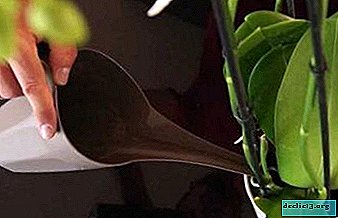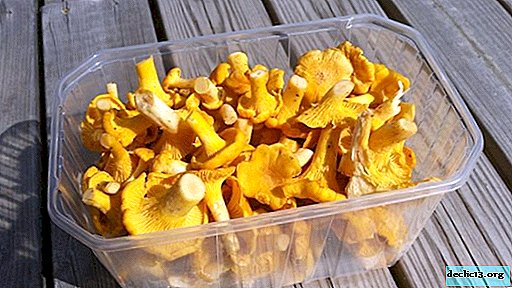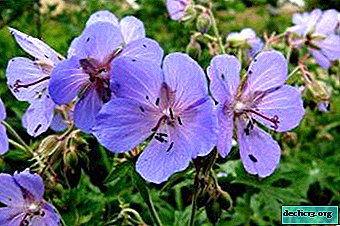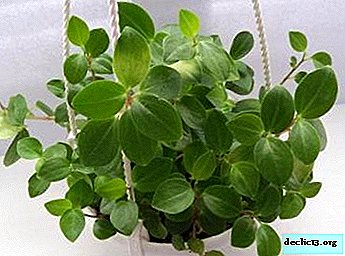All about Isadora's violet: consider a photo, appearance features and useful tips on proper care
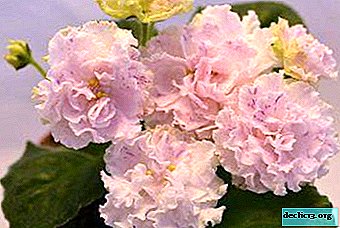
Which only violets breeders did not bring. All of them are full of diversity and diversity.
But Isadora is distinguished by her extraordinary tenderness. She copes with the task of capturing the admiring glances of others.
In this article we will talk about some features of caring for this kind of violet.
Appearance and general description of the variety
The name of this species is due to its creator - Elena Lebetskoy. She named this violet in honor of the wife of Sergei Yesenin Isadora Duncan, an American dancer. Both the flower and the beloved of the poet are associated with grace and grace. This is not surprising, because all violets of breeder Elena Lebetskaya look fragile and sensitive.
But all this delicacy is only external. In fact, it is one of the largest species. Both leaves and flowers are relatively large. And the inflorescences, in addition, are also very lush, on each of them many petals grow. The root outlet, respectively, is also rather big, from which strong stems come out.
Reference! Flowers reach a size of about 5 centimeters, up to 5 pieces are located on the peduncle. However, under the weight of the buds flower stalks bend. Isadora is characterized by abundant, but short flowering, especially in winter.The buds open very slowly, the duration of this process reaches a crescent. But in an undisclosed state, the flowers resemble a rose in their shape.
Appearance
Flowers with curly petals, double, large. Their color is pale pink. The highlight of the buds are purple, bluish and raspberry blotches and dots. These touches are called fantasy.
Their only minus is a quick blanching. A light green frill is formed on the newly opened petals, which disappears after some time. Leaf plates have dark green hues. They are also not small in size, half-double to the touch.
Photo
Below you can see a photo of Isadora's wonderful violet:





Care Features
Lighting
This kind of violet loves diffused lighting.Therefore, it must be protected from direct sunlight. It is necessary to place a flower pot on the eastern, western and northern sides of the premises. If you still put Isadora on the south windowsill, then immediately pritenite her. This can be done with paper or parchment foil by attaching them to a window.
Important! In winter, on the contrary, most likely, you will have to resort to artificial lighting, because natural may not be enough.How to water?
It should be remembered that any violet easily ruins excess watering. Therefore, you need to moisten the soil as it dries. Use water a couple of degrees above room temperature, but exclude cold water, which a gentle plant simply cannot tolerate. It is recommended that before each watering, the water be defended for a couple of days or filtered. When pouring water, make sure that it does not get on the root outlet.
It is better to resort to one of the three methods of watering.:
- Into the pallet - Leave the water for half an hour, and then drain the excess.
- Top watering - you need to do this on the edges of the flowerpot with a neat, thin stream of water.
- Wick - the most time-consuming method. For its execution, you will need to draw through the holes at the bottom of the pot, immerse one end of the water and leave the other on top of the ground.
Suitable temperature and humidity
The most optimal air temperature for Isadora will be 20-24 degrees. It is allowed to lower the mark by about five degrees. But not for long. During the hot period, check that the air temperature does not rise above 30 degrees. Violet can withstand such heat only for five days. In winter, if it is not possible to ensure optimal temperature conditions, reduce the frequency of watering.
For this class, overdrying will have a negative effect. To maintain sufficient humidity, do not forget to spray the flower. But do not overdo it, as high humidity will lead to the development of fungal diseases.
Typical planting, disease and pest control conditions
What soil to choose?
 This fragile flower will thank you for the loosened and nourished earth. Air and moisture should easily penetrate into it. Take care of the presence of a drainage layer that can be created with expanded clay or pebbles. If it is not there, water will begin to stagnate in the soil, which will lead to decay of the root system.
This fragile flower will thank you for the loosened and nourished earth. Air and moisture should easily penetrate into it. Take care of the presence of a drainage layer that can be created with expanded clay or pebbles. If it is not there, water will begin to stagnate in the soil, which will lead to decay of the root system.
A special substrate for violets is sold in stores.. But you can cook it yourself. Here is a sample list of components:
- sheet land (5 parts);
- peat (3 parts);
- sand - should be large (1 part).
Rhizomes are located closer to the surface of the earth, so when choosing a container for planting, give preference to a shallow diameter of about 7-10 centimeters. The flower growers are not advised to take a smaller size, since in such pots the roots will be crowded. And in large ones, all the power will go to filling the roots of the empty space, and not to the development of leaves and flowers.
Is additional nutrition necessary?
The answer to this question is unequivocal. I need it. But literate. Fertilizers are applied only in the spring and liquid mineral complexes are used for this. This should be done rarely: about once a month. It’s better that the soil doesn’t receive anything, than it receives excess nutrients. Isadora soil should always be a bit “hungry”.
Diseases of the curler and methods for their treatment
This plant may succumb to the following diseases.:
- Powdery mildew. It is characterized by a white coating, the appearance of which is facilitated by humidity and cold in the room. To treat this ailment, use tools such as saprol and topaz, which are recommended to be used alternately. Sulfur will also help in this situation. She needs to sprinkle a flower and cover with a film for several days.
- Late blight. Only early detection and quick reaction will save from this disease. Signs are browning of the roots and shoots, which over time will be exposed. Remove the affected parts of the flower and transplant it into a new soil.
- Fusarium. To notice this disease can be rotted leaves and root system. The formation of fusarium is preceded by improper care of the plant. To cure it, remove the damaged parts, and treat the remaining parts with a solution of baseazole.
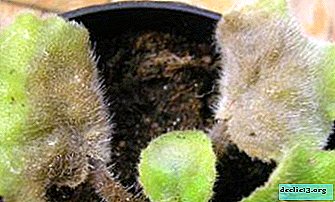 Gray rot. Its danger lies in the fact that it is able to infect neighboring flowers. You will see the disease by a fluffy coating of gray-brown color. Gray rot instantly infects the entire plant. To stop its development, get rid of the infected areas, and spray the rest with fungicidal preparations. If Isadora could not be saved, do not spare the soil in which she grew up - throw it away with the dead violet.
Gray rot. Its danger lies in the fact that it is able to infect neighboring flowers. You will see the disease by a fluffy coating of gray-brown color. Gray rot instantly infects the entire plant. To stop its development, get rid of the infected areas, and spray the rest with fungicidal preparations. If Isadora could not be saved, do not spare the soil in which she grew up - throw it away with the dead violet.- Rust. The appearance of dirty yellow tubercles is characterized. To avoid this ailment, do not allow residual drops of water on the leaves, especially in a warm, humid climate.
Pests attacking a plant
- Worms. Their danger lies in the deformation of the sheet plate. And on the bite sites brown or reddish spots appear. If this parasite is found on the leaves or flowers of Isadora, treat it with such drugs: phytoverm, actara, actellic.
- Thrips. Usually plants with flowers or poplar fluff fall on the surface of the plant. Their attack directed the buds. To protect the violet, use for this acarine, vertimec, gravertine, as well as dantop.
- Aphid. Also a frequent guest on Isadora. Through their fault, young shoots dry up, which prevents the plant from developing and rejuvenating. To combat aphids, use soapy water. If there are too many of these insects, it is better to resort to the help of insecticidal preparations.
- Different types of ticks: red arachnoid, cyclamen, arachnoid. As soon as you notice them on your beauty, immediately treat her with a fitoverm, acarin or an actress.
But I want to note that any violet is a plant that rarely gives in to pests and diseasesif you follow all the recommendations for care. Therefore, in addition to treating the plant with various means, review Isadora's living conditions.
And in conclusion, we note that all of the above items are not particularly difficult to comply with. You just need to do everything on time and systematically. And then the beautiful Isadora will thank you with a rapid and long flowering and the absence of problems with her. Feel free to get for yourself this symbol of tenderness and grace.

 Gray rot. Its danger lies in the fact that it is able to infect neighboring flowers. You will see the disease by a fluffy coating of gray-brown color. Gray rot instantly infects the entire plant. To stop its development, get rid of the infected areas, and spray the rest with fungicidal preparations. If Isadora could not be saved, do not spare the soil in which she grew up - throw it away with the dead violet.
Gray rot. Its danger lies in the fact that it is able to infect neighboring flowers. You will see the disease by a fluffy coating of gray-brown color. Gray rot instantly infects the entire plant. To stop its development, get rid of the infected areas, and spray the rest with fungicidal preparations. If Isadora could not be saved, do not spare the soil in which she grew up - throw it away with the dead violet.